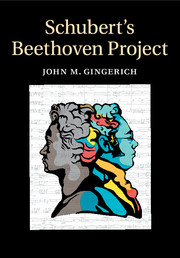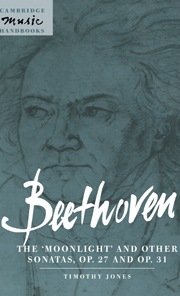Schubert's Beethoven Project
£36.99
- Author: John M. Gingerich
- Date Published: September 2016
- availability: Available
- format: Paperback
- isbn: 9781316621257
£
36.99
Paperback
Other available formats:
Hardback, eBook
Looking for an inspection copy?
This title is not currently available on inspection
-
Why couldn't Schubert get his 'great' C-Major Symphony performed? Why was he the first composer to consistently write four movements for his piano sonatas? Since neither Schubert's nor Beethoven's piano sonatas were ever performed in public, who did hear them? Addressing these questions and many others, John M. Gingerich provides a new understanding of Schubert's career and his relationship to Beethoven. Placing the genres of string quartet, symphony, and piano sonata within the cultural context of the 1820s, the book examines how Schubert was building on Beethoven's legacy. Gingerich brings new understandings of how Schubert tried to shape his career to bear on new hermeneutic readings of the works from 1824 to 1828 that share musical and extra-musical pre-occupations, centering on the 'Death and the Maiden' Quartet and the Cello Quintet, as well as on analyses of the A-minor Quartet, the Octet, and of the 'great' C-Major Symphony.
Read more- Provides an innovative approach to the subject, bringing together fields of inquiry that are usually separate – history, analysis, theory and hermeneutics
- Presents new observations of Schubert's career, including the significance of performances of Schubert's music by the violinist Schuppanzigh and his ensemble
- Written as an entertaining historical narrative, the book provides new findings about Schubert which will be of key interest to music scholars
Reviews & endorsements
'… presents intriguing evidence that Schubert followed Beethoven's example by composing substantial works such as symphonies, piano sonatas, and string quartets for public performance and publication … Gingerich's investigation casts new light on Schubert's late instrumental works and shows how, even though inspired by Beethoven, Schubert imbued them with his highly personal style. A thought-provoking contribution to Schubert scholarship … Essential.' D. Arnold, Choice
See more reviews'… a new height and intensity in terms of the composers own musical outlook, would make such an idea an attractive one to contemplate …' Seow-Chin Ong, 1650–1850
Customer reviews
Not yet reviewed
Be the first to review
Review was not posted due to profanity
×Product details
- Date Published: September 2016
- format: Paperback
- isbn: 9781316621257
- length: 376 pages
- dimensions: 245 x 170 x 20 mm
- weight: 0.65kg
- contains: 10 tables 83 music examples
- availability: Available
Table of Contents
Introduction
1. Preparations
2. The year of crisis, 1823
3. Schuppanzigh and Schubert's chamber music
4. Songs of death and the chamber music of 1824
5. Schubert's first public quartet and sonata form
6. Schubert's octet and Beethoven's septet
7. The Gesellschaft der Musikfreunde, Schubert, and his symphony
8. Schubert's heroic symphony
9. The piano sonatas of 1825–6
10. Schubert and his publishers
11. The E flat trio, Schubert's career, and its last two movements
12. Schubert's annus mirabilis and the string quintet
Bibliography.
Sorry, this resource is locked
Please register or sign in to request access. If you are having problems accessing these resources please email [email protected]
Register Sign in» Proceed
You are now leaving the Cambridge University Press website. Your eBook purchase and download will be completed by our partner www.ebooks.com. Please see the permission section of the www.ebooks.com catalogue page for details of the print & copy limits on our eBooks.
Continue ×Are you sure you want to delete your account?
This cannot be undone.
Thank you for your feedback which will help us improve our service.
If you requested a response, we will make sure to get back to you shortly.
×





